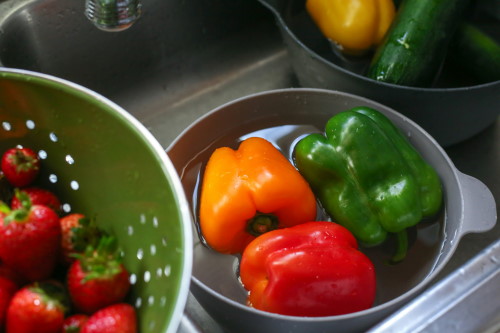If you’re like many consumers, you’ve noticed your grocery bills have been taking a pretty big hit. With increasing costs, you may be rethinking your choices to stick to your budget. One of those considerations is likely how much or how often you purchase organic fruits and vegetables. Of course, it’s still important to consume a wide variety of produce. And to help decrease your exposure to contaminants, it’s a good idea to fully clean fruits and vegetables (organic or conventionally grown) before you eat them.
BREAKING: Shed 42 lbs In 30 Days With This Simple Night-time Pill
Increasing Grocery Bills
While inflation levels aren’t soaring as much as they were during the pandemic (with retail prices of vegetables surging almost 20% in the first year), prices have continued to be volatile. So, if your grocery bill seems a bit pricier than it was in the past, it’s likely not your imagination. According to the Produce Blue Book, fruit prices dipped slightly (by 0.3%) in 2023 vs. 2022 compared to the 7.6% increase in 2020 and early 2021. And vegetable prices have gone up by about 2.4% (compared to 6% in 2020). There is, however, continued volatility, depending on where the produce is grown.
Thankfully, despite the various market pressures and price fluctuations, the demand for fresh produce has continued to grow, especially as we head into the summer and grilling seasons. So, customers continue to reach for fresh produce even through economic challenges. Hopefully, this highlights our understanding of how important fruits and vegetables are to a healthy diet.
With increased grocery costs across the board, however, many people are reconsidering some of the foods they may have picked in the past. For instance, as organic vegetables and fruits are typically more expensive than conventionally grown produce, many of us are starting to choose, or at least consider, lower-cost options.
Don’t get me wrong. There are still plenty of enticing benefits when it comes to choosing organic produce. This includes the focus on environmental protection, improved animal welfare, and more resilient crops that are better able to withstand droughts and floods. Plus, organic farms encourage more diverse agricultural output. That greater diversity means greater food value.
In addition, there are concerns about the chemical cost of conventionally grown veggies, which often have a larger load of pesticides, herbicides, and chemical fertilizers that can leave concerning residues on plant foods.
That said, if you find it challenging to find affordable organic produce (or are just cutting back on the costs of groceries), it’s still unequivocally better to eat conventionally grown veggies than no vegetables at all. A wide array of vegetables and fruits, however they’re grown, is still highly beneficial. That also means it’s even more important to fully clean fruits and vegetables.
How to Fully Clean Fruits and Vegetables
Fully cleaning your vegetables and fruits helps remove chemical residues like pesticides, herbicides, and fertilizers. It also helps remove pathogens (e.g., bacteria and viruses) that can lead to digestive woes or foodborne illness.
To fully clean fruits and vegetables, start by running them under cold running water and gently rub off any residue or dirt with your hands, a clean cloth, or a vegetable brush. If you’re working with greens, remove the outermost leaves, as these often have the most residue.
Then, place your produce in a bowl filled with cold water. Allow it to soak for just a few minutes to loosen any remaining particles. You can also use your hands to gently agitate the water to help remove dirt and debris.
A solution made with water and vinegar (~1 part vinegar to 3 parts water) may be even more effective for breaking down chemicals and helping disinfect and kill bacteria. Another method is to soak your vegetables in a baking soda solution (with about a teaspoon of baking soda in a few cups of cold water) to help remove more tenacious residue.
You’ll want to limit soaking to just a few minutes for delicate produce. Or for up to 10 minutes for more hearty options, like cauliflower, and up to 15 minutes for carrots or potatoes. Then, rinse them thoroughly with clean water to wash away any contaminants as well as any lingering vinegar or baking soda smell or taste.
Next, dry the produce completely before storing or using it to cook. You can use a clean dish towel to pat it dry. Or use a salad spinner to remove excess water, especially if you’re working with leafy vegetables. Damp produce can lead to mold growth, especially if it’s stored after it’s been washed. So don’t skip this crucial step.
These steps are effective with leafy greens, cruciferous vegetables like broccoli and cauliflower, tomatoes, etc.
For larger vegetables, it can help to cut them into smaller pieces before cleaning to ensure you hit all surfaces, especially the stems, where dirt and contaminants may accumulate. For hearty vegetables like carrots, potatoes, or squash, you may also need more than your fingers to scrub off any visible dirt. In that case, you can use a clean, soft brush under running water to clean them completely. (Have a separate vegetable brush that’s used only for washing veggies, and keep that clean and dry between uses.)
While the above steps work well for most vegetables and fruits, you’ll want to adjust them slightly for others based on their structure and texture. For example, mushrooms can easily absorb water. So, it’s best to either gently wipe them with a damp cloth or quickly run them under water and then dry them immediately. Soaking mushrooms isn’t recommended as it can make them soggy and damage their texture.
Berries, including strawberries, blueberries, blackberries, and raspberries, also need slightly different treatment. Because they’re so delicate, they’re prone to molding and bruising. So, wash them gingerly under cold water before using them. You can also soak them (in either water or a diluted vinegar rinse) to help kill any bacteria and potentially extend their shelf life. However, you’ll want to avoid soaking them for more than a couple of minutes, as the berries could absorb the liquid and become mushy. If you do choose to use a vinegar rinse, remember to then completely rinse them using cold water to remove any lingering vinegar notes.
Herbs are also delicate, so a long soak should be avoided, as this could cause them to wilt and lose flavor. Instead, they can be washed in a cold bowl of water, gently agitating with your fingers, before rinsing quickly under running water. Then dry them with a towel or in a salad spinner and use them immediately.
The key with most vegetables is to avoid soaking them for too long, as this could cause them to absorb water and lose nutrients. Then, make sure they’re fully dry before they’re stored or used to prevent them from spoiling or getting moldy.
Minimizing Exposure to Contaminants
In addition to ensuring you fully clean fruits and vegetables, there are other simple steps you can take to help minimize your exposure to potentially harmful chemicals and pathogens. These include:
- Peeling or removing the outer layers, as contaminants typically reside on the surface of the produce. However, peeling also reduces the amount of fiber and other nutrients in many vegetables since many nutrients tend to be concentrated in or just under the skin.
- Buy organic, especially when purchasing produce that tends to have the highest load. In 2023, the “Dirty Dozen” foods included strawberries, spinach, kale, collard and mustard greens, peaches, pears, nectarines, apples, grapes, bell and hot peppers, cherries, blueberries, and green beans. In contrast, the Clean 15 foods have lower levels of pesticide contamination (so it may be less important to buy organic). These include avocados, sweet corn, pineapples, onions, papayas, sweet peas (frozen), asparagus, honeydew melons, kiwis, cabbage, mushrooms, mangos, sweet potatoes, watermelons, and carrots.
- Choose local and seasonal produce, which tends to be fresher and may need fewer chemicals as it doesn’t need to stay “fresh” to travel long distances or require extensive preservation. Local farmers (as opposed to large corporate farms) may also be more likely to support sustainable practices, even if they aren’t officially organic. If you have a local farmer’s market, you can chat with the growers about their values and practices.
- Consume a diverse diet with a wide range of vegetables and fruits. Doing so limits the risk of exposure to chemicals concentrated in monocrops. And different plants tend to accumulate different types of chemicals. It all depends on the farming and processing methods.
- Grow your own, which gives you full control over the use of chemicals, supplies the freshest produce available, and is an enjoyable and health-enhancing hobby. You can even choose to grow just a few herbs or vegetables in containers if you live in a smaller home, condo, or apartment or don’t have the time or energy to manage a full garden.
- Store your produce correctly, as some vegetables and fruits emit natural gases that can accelerate the rate the produce around them spoils. Not only can this lead to wasted vegetables (as you have less time to eat them before they go bad), but it can also increase the concentration of chemical contaminants. Not sure how to store them for the longest life?.
- Use a produce wash, such as one you find commercially or one you make your own (see vinegar or baking soda mixes above). The effectiveness of these washes varies, but they may help remove more contaminants (microbial as well as pesticide) than water alone. For instance, a study in the journal Food Control found a 10% vinegar solution removed bacteria and viruses better than water alone. Commercial (saltwater) washes were found to be as effective for removing pesticide residues as the vinegar solution. Other research from the University of Massachusetts, Amherst, found that soaking apples in a baking soda solution (1 tsp of baking soda per 2 cups of water) for 12 to 15 minutes was also better than water alone for removing pesticide residue. The effectiveness of these solutions will depend on what’s in the wash, the produce being washed, and the type of pesticide residue on the produce.
TRENDING: Newly Legalized Herb Relieves Pain - Available Without A Prescription
Fully Clean Fruits and Vegetables Takeaways
What’s most important, at the end of the day, is that you continue to enjoy a wide range of these nutrient-dense powerhouses. Whether you choose to buy organic or conventionally grown vegetables and fruits, make sure you wash them well to remove dirt, debris, pathogens, and chemical residue. And if you are buying conventionally grown vegetables and fruits, cleaning them well also helps reduce the chemical load from the foods you consume. Fortunately, with the tips above, it’s easy to fully clean fruits and vegetables before you eat, store, or cook with them.









